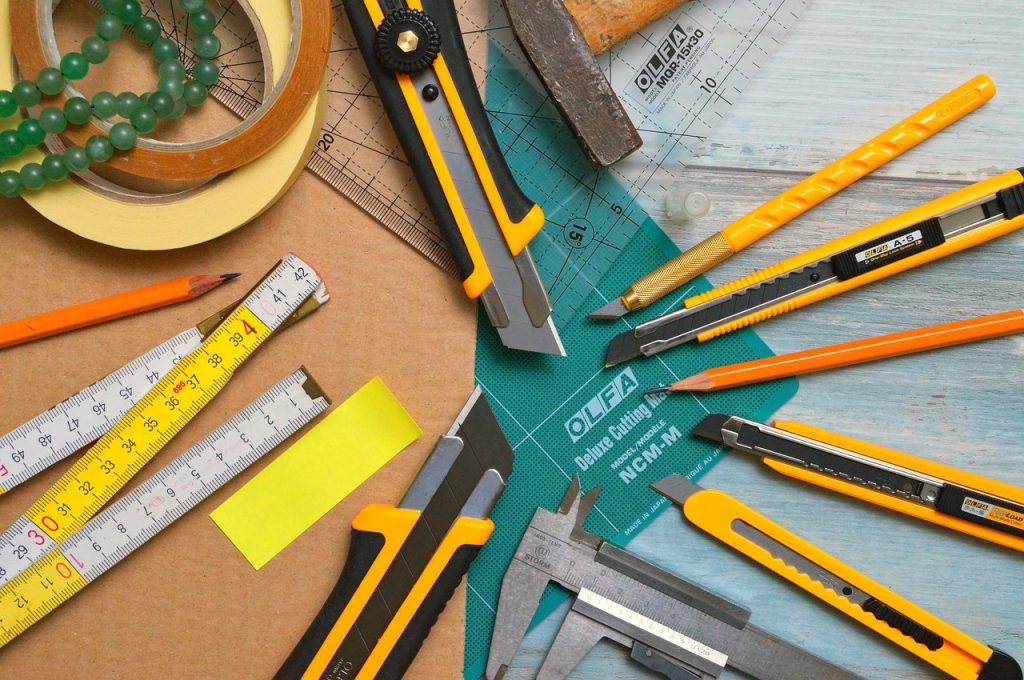Craft knives have many different uses for the hobbyist. Cutting scrapbook paper, foam, or even small pieces of wood requires a blade that makes it easy to create unique shapes for any project. Ideal craft knives are no wider than a pencil, which gives the crafter more precise control over their design.
Despite their small size, there are still some risks when these tools are not properly used. These safety tips can help even a novice crafter use knives with confidence and lower their injury risk.
Table of Contents
Crafting Equipment
Before beginning any project that requires cutting, crafters should first gather the necessary crafting equipment. This equipment includes a crafting knife and a non-slip cutting board, ruler or straight edge, and marking tool.
There are cutting mats made for those who use craft knives. These boards are made from rubber material designed to keep the cutting surface still when in use. A cutting mat protects the table or countertop and offers a stable, firm surface for craftwork.
Straight edges allow crafters to make consistent straight lines when needed. Some projects require cutting in curves or intricate designs that do not need a straight edge as a guide. Whether or not the task requires a perfectly straight cut, it doesn’t hurt to have a straight edge available.
A marking tool, such as a pencil, can help to define the shape before cutting begins. Drawing out the design onto the medium allows crafters to see how the finished product looks before making the first cut. It saves frustration and supplies if the imagined shape doesn’t look quite right. It also gives the cutter a guide to follow when using the craft knife.

Using a Craft Knife
When it comes to using craft knives, crafters must be careful not to cut themselves or others. To start, inspect the knife when removing it from storage. The collar of the handle should be tight so the blade does not slip out during use. The blade itself should be in good condition. Replace and adequately dispose of dull blades.
Use the craft knife by securely gripping the handle to keep it from slipping. The best place to hold it is to grasp the collar as if it were a pencil. This placement of the gripping fingers allows for better control over the knife.
Secure the material with the non-cutting hand. Keep that hand away from the blade. If the material is too small to safely keep the non-cutting hand away from the craft knife, secure it with pins or tape. Keeping the material secure helps to reduce the risk of accidents and offers a cleaner cut.
Do not pull the blade towards the body. Make cuts in the opposite direction for the safest results. Then, if the craft knife slips, it won’t cause bodily harm.
Make shorter cuts and score the material when possible. Shorter cuts allow users to keep better control over the knife. Scoring on thicker material keeps users from damaging the blade and potentially causing injuries. Don’t press harder than necessary with the craft knife, as this may damage or break it.
Always be aware of your surroundings and concentrate on the task at hand. Being aware of who is in the room prepares crafters for potential bumps or distractions. Focus helps to avoid incidents.
Storage

Craft knife safety isn’t limited to the times when you’re using the knife. While most lacerations occur during use, the blade’s storage can also cause safety problems. Never store a craft knife without the protective cover. If the craft knife has a retractable blade, ensure it is fully retracted before putting it away. Those with plastic caps should have them secured. If the lid is lost, use a cork or sleeve to cover the edge. Never put an uncovered blade in bags or pockets.
If the craft knife is not in use, cover the blade, even if it is on the tabletop for later use. Covering the tip even when not storing reduces the risk of accidental lacerations. Never leave the knife lying in a chair or on the floor.
Disposal
Blades that don’t work properly need to be replaced. When this becomes necessary, be sure to safely dispose of the old blade. Keep a sharps container handy for old blades and dispose of the box properly when it is full. If possible, recycle the blades. Never throw an old blade into the trash can without protecting the edge.
Maintenance
Not all craft knives require regular maintenance. Most companies design the blades so that they are replaced rather than sharpened. However, users should always check their knives for wear that makes them unsafe to use. The tool should be regularly cleaned. Craft knives with collars that do not stay tight should be replaced. Check the manufacturer’s requirements for proper maintenance.
Crafters should always follow craft knife safety tips. It all starts with choosing the right equipment for the project. You must use the knife safely, cutting away from yourself and others. Never store the craft knife without the protective cap. Safely dispose of old blades and adequately maintain the knife. With these precautions, craft projects are enjoyable, and the crafter reduces the risk of accidents.
Featured Image by rawpixel.com



